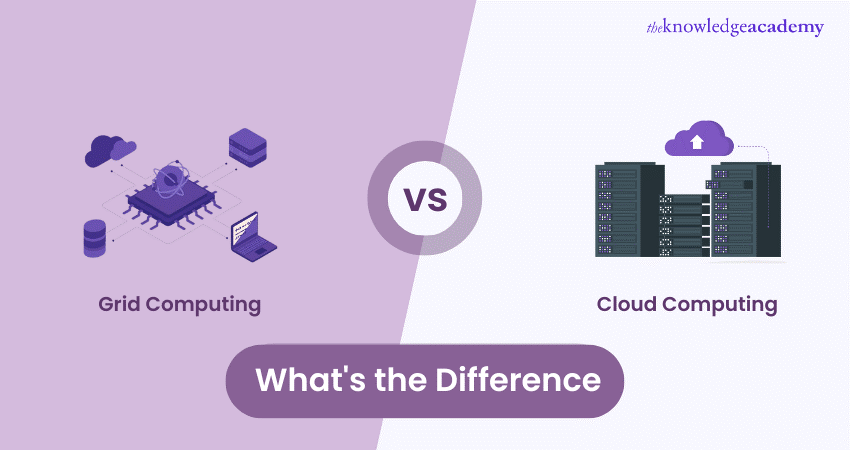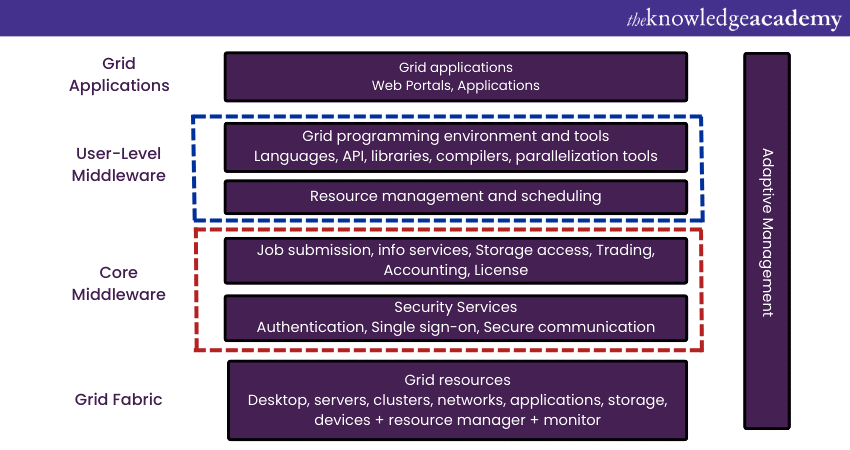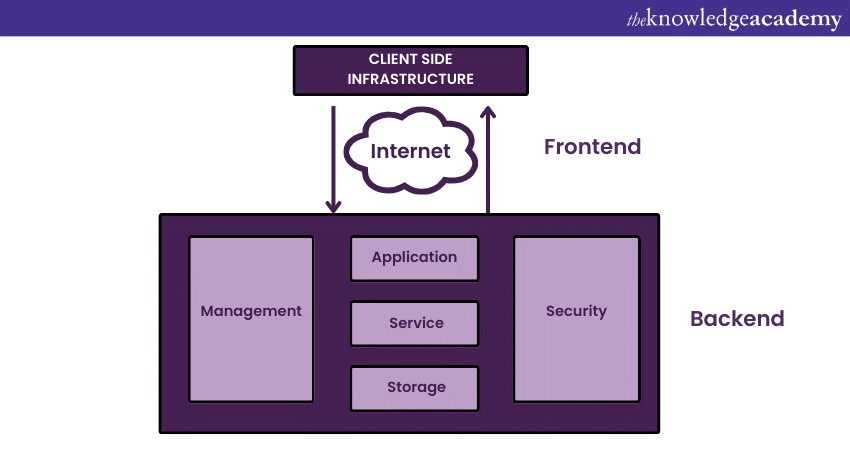We may not have the course you’re looking for. If you enquire or give us a call on 01344203999 and speak to our training experts, we may still be able to help with your training requirements.
Training Outcomes Within Your Budget!
We ensure quality, budget-alignment, and timely delivery by our expert instructors.

Digital transformation has led to greater demand for efficient and scalable computing solutions. Two prominent contenders in this arena are Grid Computing and Cloud Computing. While they share similarities in their distributed approach, they differ significantly in their architecture, applications, and use cases. To navigate the choices and determine the most suitable solution, it's crucial to understand the differences between Grid Computing vs Cloud Computing.
In this blog, we delve into the world of Grid Computing and Cloud Computing, exploring the key differences and shedding light on their use cases and properties.
Table of Contents
1) What is Grid Computing?
a) Grid Computing use cases
2) What is Cloud Computing
a) Cloud Computing use cases
3) Differences between Grid Computing and Cloud Computing
4) Conclusion
What is Grid Computing?
Grid Computing is a distributed computing paradigm that harnesses the collective power of interconnected computers to solve complex computational tasks. Unlike traditional computing, where a single supercomputer or server handles tasks, Grid Computing networks numerous geographically dispersed computers, often referred to as "nodes" or "resources," into a unified virtual infrastructure.
Grid Computing operates on the principle of resource sharing, allowing organisations to tap into underutilised computing power across their network, effectively creating a virtual supercomputer. This approach is highly scalable, making it ideal for handling tasks that demand significant computational resources, such as scientific simulations, data analysis, and large-scale simulations.
A key feature of Grid Computing is its ability to handle diverse workloads and allocate tasks dynamically, enhancing overall efficiency. Grids are commonly used in scientific research, engineering, and industries requiring extensive data processing, enabling more efficient problem-solving and resource utilisation. Grid Computing has paved the way for Cloud Computing and plays a crucial role in addressing complex problems in our data-driven world.
Grid Computing Architecture

Grid Computing is a standardised system that unites different categories of servers, networks, and storage systems to appear as a single computing entity to the user. It typically consists of three machine types:
a) A control node or server is responsible for managing the entire network and overseeing the available resources in an online pool. This can be a single server or a collection of servers.
b) A provider or grid node which contributes resources to the network resource pool.
c) A user is a machine that utilises network resources to perform tasks, often referred to as a resource user.
Each machine connected to the grid runs specialised Grid Computing software responsible for coordinating tasks within the grid. This software breaks down the main workload into smaller tasks, assigning each computer one of these smaller tasks. This allows all computers to work on their respective subtasks simultaneously. Once completed, the results from each computer are combined to finalise the larger main task.
The software also facilitates communication and information sharing among computers working on subtasks, enabling them to collaboratively produce output for the main job. Grid Computing is a form of distributed computing where a virtual supercomputer aggregates the resources of multiple separate computers located across different geographic locations. In a grid, computers share resources like processing power, internet connectivity, and storage space to tackle computationally intensive tasks. In essence, the grid structure creates a unified computational unit.
Grid Computing use cases
Grid Computing finds extensive applications across various industries, offering valuable solutions:
a) Finance: Financial institutions leverage Grid Computing to enhance risk management. By harnessing pooled processing power, they expedite portfolio adjustments in volatile markets.
b) Healthcare: The healthcare sector employs grid computing to manage vast amounts of patient data for personalised therapy, medical research, and disease outbreak control, revolutionising patient care and research efforts.
c) Media: Special effects in movies often require substantial computing resources. Grid Computing aids special effects creators by accelerating production timelines through the distribution of processing tasks.
d) Gaming: Game producers benefit from Grid Computing, which provides additional processing power for tasks like in-game graphics design. This approach accelerates Game Development and improves efficiency.
e) Life sciences: In the rapidly advancing field of life sciences, Grid Computing finds widespread use. It supports biological computation, bioinformatics, and neuroscience, facilitating efficient data access, large-scale simulations, and device integration for healthcare infrastructure.
What is Cloud Computing?
Cloud Computing is a transformative technology that has reshaped the way we store, access, and manage data and applications. It involves the delivery of computing services, such as servers, storage, databases, networking, software, analytics, and intelligence, over the internet or "the cloud." Instead of relying on local servers or personal devices, Cloud Computing harnesses the power of remote data centres to provide these resources on demand.
There are various deployment models within Cloud Computing, including public, private, and hybrid clouds. Public clouds are operated by third-party service providers and offer resources to multiple users, while private clouds are dedicated to a single organisation. Hybrid clouds combine elements of both.
Cloud Computing offers several advantages, such as scalability, cost-effectiveness, and flexibility. Users can access services and data from virtually anywhere with an internet connection. It has become the backbone of modern businesses, driving innovation and efficiency across various industries, from startups to large enterprises. In essence, Cloud Computing has revolutionised the way we leverage technology resources, making computing power more accessible and adaptable to diverse needs.
Cloud Computing Architecture

Cloud architecture, the foundation for Cloud Computing, involves the intricate interaction and connection of various cloud components, including technology, simulated resources, programming skills, and network systems. This architectural framework serves as a guide for effectively integrating these resources to create a cloud-based system tailored for specific business purposes. It combines event-based and service-driven design principles.
The architecture of Cloud Computing comprises two distinct parts: the front end and the back end, which communicate via the Internet. The front end encompasses client facilities, such as user interfaces, user-side applications, and client networks or devices, enabling users to access and utilise cloud services. On the other hand, the back end encompasses all the elements involved in establishing the cloud infrastructure, including management, security, computing and storage resources.
All components of Cloud architecture collaborate to provide the foundation for Cloud Computing, offering users on-demand access to a variety of services and resources. The front end communicates user interactions to the back end through middleware, where the application's service model executes requested actions. As cloud strategies evolve, the expertise of cloud architects becomes increasingly vital as they assist businesses in navigating the complexities of cloud environments, implementing effective strategies, and ensuring the seamless operation of the cloud infrastructure.
Cloud Computing use cases
Cloud Computing offers various benefits for testing, development, analytics, email services, and infrastructure management, contributing to increased efficiency and productivity in businesses.
a) Testing and development: Cloud's flexibility allows for quick and cost-effective establishment, testing, and decommissioning of environments. This agility enables companies to reduce deployment times, boosting productivity and expediting product launches.
b) Analytics on large amounts of data: Through Big Data Analytics, businesses can harness the computational power of the cloud to gain valuable insights. The vast amounts of data generated by interactions between corporate endpoints, cloud apps, and consumers can be organised and analysed to optimise operations and drive profits.
c) Analytics based on Big Data: Big Data is transforming business operations by collecting data on consumer preferences and behaviours, allowing companies like Facebook and Amazon to predict purchases and expand their businesses.
d) Email services: Email, typically offered as Software as a Service (SaaS), is integral to various business operations and can be accessed online. Cloud-based email services are essential for functions in sales, Marketing, IT, and other departments.
e) Infrastructure services: Managing infrastructure involves substantial costs related to hardware, electricity, and maintenance. Many businesses opt to host their data in third-party data centres, minimising capital expenses and focusing on operational efficiency.
Elevate your career with Cloud Computing Training and become a skilled expert in the world of cloud technology.
Differences between Grid Computing and Cloud Computing
|
Aspect |
Grid Computing |
Cloud Computing |
|
Resource ownership |
Diverse organisations |
Cloud service provider |
|
Scalability |
Limited within federation |
Elastic, on-demand |
|
Cost model |
Complex resource-based |
Pay-as-you-go, predictable |
|
Workload type |
Specialised applications |
Versatile, various workloads |
|
Location independence |
Resource-dependent |
Location-independent |
|
Resource heterogeneity |
Often heterogeneous |
Standardised resources |
|
Resource utilisation |
Requires careful management |
Automated optimisation |
|
Deployment and maintenance |
Complex setup |
Easy deployment, low maintenance |
|
Accessibility |
Varies by federation |
Globally accessible |
|
Security |
Diverse security levels |
Comprehensive provider security |
Resource ownership:
Grids are typically composed of resources that are owned and managed by various organisations, institutions, or individuals. These resources can be geographically dispersed and can vary significantly in terms of hardware, software, and configurations. The coordination of tasks and data sharing in Grid Computing often involves complex negotiations and agreements among resource owners.
In contrast, Cloud Computing is characterised by a centralised model where a single service provider owns and manages the entire infrastructure. The cloud provider delivers resources and services to users on a pay-as-you-go basis, offering a unified and standardised environment. Users of Cloud Computing don't need to concern themselves with the underlying infrastructure, as it is abstracted away from them.
Scalability:
Grids are designed for high-performance and data-intensive computing, often for scientific, research, and technical applications. They can accommodate large-scale computations, making them suitable for projects that require significant processing power and storage capacity. However, scalability in Grid Computing can be challenging due to the diversity of resources and the need for resource management.
Clouds are highly scalable and flexible, with the ability to allocate or de-allocate resources on-demand. Cloud providers offer a range of service models, including Infrastructure as a Service (IaaS), Platform as a Service (PaaS), and Software as a Service (SaaS). This flexibility allows Cloud Computing to cater to a broad spectrum of applications, from small-scale web hosting to large-scale Data Analytics.
Resource sharing:
Grids are founded on the principle of resource sharing among multiple organisations and research institutions. Collaboration and data sharing are fundamental to Grid Computing, with tasks often distributed across different administrative domains. This makes Grid Computing suitable for collaborative, data-intensive projects, such as climate modelling and particle physics.
Cloud Computing, on the other hand, is primarily designed to provide services and resources to end-users and businesses. Resource sharing is limited to the cloud provider's infrastructure and is typically not extended to other organisations. Cloud services are more focused on delivering applications and services directly to users.
Empower your development teams with Microservices Architecture Training and stay at the forefront of modern software design.
Cost structure:
The cost structure in Grid Computing can be intricate, involving negotiations and agreements among organisations participating in a grid. These organisations may share the costs of infrastructure, maintenance, and resource usage, making grids suitable for long-term, large-scale projects. The financial model can be project-based or collaborative, depending on the specific needs of the participants.
Cloud services usually follow a pay-as-you-go model, where users are billed for the resources they consume. This cost structure is well-suited for businesses with variable workloads, as they can scale resources up or down as needed, optimising costs. Users are only charged for the services they use, providing cost-effectiveness for a wide range of applications.
Service models:
Grid Computing primarily focuses on compute and data-intensive tasks. Users often have to manage the resources and tasks themselves, as grids provide a more low-level infrastructure. Grid Computing is commonly used for specialised research and scientific applications.
Clouds offer a wide array of service models, including IaaS, PaaS, and SaaS. IaaS provides virtualised infrastructure, PaaS offers platforms for developing and deploying applications, and SaaS delivers complete software solutions. Users can select the service model that best matches their specific needs, simplifying the deployment and management of applications and services.
Elasticity:
Grids typically lack the automatic scalability and elasticity found in cloud services. Users often need to manually allocate and manage resources, which can be complex and time-consuming. This manual resource management makes Grid Computing less agile in responding to fluctuating workloads.
Clouds are known for their automatic scalability and elasticity. Resources can be provisioned or de-provisioned based on demand, allowing users to adapt to workload fluctuations efficiently. This elasticity contributes to cost-efficiency and flexibility, making Cloud Computing particularly attractive for businesses with variable resource requirements.
Unlock the potential of Cloud Computing with our expert-led Cloud Computing Courses. Register now!
Conclusion
Grid Computing and Cloud Computing are distinct approaches to distributed computing, each with its own set of advantages and applications. Grid Computing excels in scientific research and complex problem-solving, while Cloud Computing offers scalability and versatility for a broader range of tasks. Understanding Grid Computing vs Cloud Computing is crucial for choosing the right solution.
Frequently Asked Questions
Upcoming Cloud Computing Resources Batches & Dates
Date
 Cloud Computing Training
Cloud Computing Training
Thu 13th Feb 2025
Thu 10th Apr 2025
Thu 12th Jun 2025
Thu 14th Aug 2025
Thu 9th Oct 2025
Thu 11th Dec 2025







 Top Rated Course
Top Rated Course



 If you wish to make any changes to your course, please
If you wish to make any changes to your course, please


